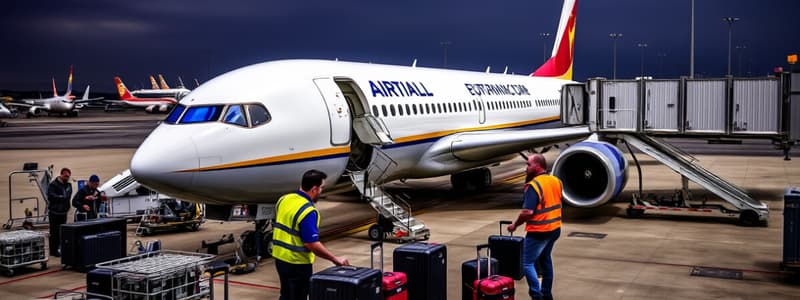Podcast
Questions and Answers
What is the primary purpose of pre-flight checks?
What is the primary purpose of pre-flight checks?
- To ensure aircraft systems and equipment are operational (correct)
- To assist passengers during boarding
- To initiate fueling procedures
- To direct aircraft on the tarmac
Which equipment is used to provide power to parked aircraft?
Which equipment is used to provide power to parked aircraft?
- Fuel trucks
- Ground Power Units (GPUs) (correct)
- Pushback tractor
- Baggage carts
What guideline is most commonly followed during the boarding process?
What guideline is most commonly followed during the boarding process?
- Random boarding assignments
- Unaccompanied minor first boarding
- Zone or group boarding (correct)
- First come, first served
What is the main goal of baggage load planning?
What is the main goal of baggage load planning?
What does security screening primarily aim to achieve?
What does security screening primarily aim to achieve?
What is a critical aspect of fueling procedures?
What is a critical aspect of fueling procedures?
Which of the following is not part of baggage handling procedures?
Which of the following is not part of baggage handling procedures?
What is the requirement for ground staff regarding safety protocols?
What is the requirement for ground staff regarding safety protocols?
Study Notes
Aircraft Handling
- Pre-flight Checks: Inspection of aircraft systems and equipment before departure.
- Marshallers: Ground personnel directing aircraft on the tarmac using hand signals.
- Pushback Operations: Procedures for moving the aircraft away from the gate using tow vehicles.
- Ground Power Units (GPUs): Equipment supplying power to aircraft while on the ground.
- Fueling Procedures: Safe methods for refueling aircraft, including equipment checks and spill prevention.
Passenger Services
- Check-in Process: Procedures for passengers to confirm their flight and receive boarding passes.
- Boarding Procedures: Guidelines for orderly boarding, often using zones or groups.
- Customer Support: Assistance provided to passengers for inquiries, complaints, and special needs.
- Lounges and Amenities: Services offered to passengers in airport lounges, such as refreshments and Wi-Fi.
Baggage Handling
- Baggage Check-In: Process for passengers to check their luggage before boarding.
- Sorting Systems: Automated systems for efficiently sorting and directing baggage to appropriate flights.
- Load Planning: Arrangement of baggage in the aircraft to maintain balance and comply with weight limits.
- Claims and Lost Baggage: Procedures for reporting lost baggage and compensation policies.
Safety Protocols
- Security Screening: Procedures for screening passengers and luggage for prohibited items.
- Emergency Procedures: Guidelines for responding to accidents or emergencies on the ground.
- Hazardous Materials Handling: Regulations for transporting and storing hazardous materials in aviation.
- Training and Certification: Requirement for ground staff to undergo safety training and obtain necessary certifications.
Aircraft Handling
- Pre-flight checks ensure all aircraft systems, such as navigation and safety equipment, are functioning correctly before takeoff.
- Marshallers use standardized hand signals to guide pilots when maneuvering aircraft on the tarmac, enhancing safety and efficiency.
- Pushback operations utilize specialized tow vehicles to safely move the aircraft from the gate, adhering to specific protocols to prevent damage.
- Ground Power Units (GPUs) provide essential electrical power to aircraft while stationary, allowing onboard systems to operate without engaging engines.
- Fueling procedures include stringent safety measures, equipment inspections, and spill prevention techniques to maintain safe refueling operations.
Passenger Services
- The check-in process allows passengers to verify their flight details and obtain boarding passes, often facilitated through self-service kiosks or staff assistance.
- Boarding procedures are key to maintaining an orderly flow, with passengers typically boarding by designated zones or groups to reduce congestion.
- Customer support addresses passenger inquiries, complaints, and special needs, ensuring a positive travel experience through effective service.
- Lounges and amenities enhance the passenger experience with services like refreshments, comfortable seating, and Wi-Fi access in airport lounges.
Baggage Handling
- Baggage check-in is the systematic process where passengers hand over their luggage for secure transport on their flight.
- Sorting systems utilize advanced technology to automatically sort and route baggage to corresponding flights, improving efficiency in the handling process.
- Load planning involves strategically arranging baggage within the aircraft to ensure proper weight distribution and aircraft balance, which is critical for safety.
- Claims and lost baggage procedures enable passengers to report missing luggage and understand the compensation processes for lost items.
Safety Protocols
- Security screening involves thorough checks of passengers and their luggage to identify and prevent prohibited items from entering secure areas.
- Emergency procedures are established protocols for staff to follow in the case of accidents or emergencies, ensuring passenger safety and an organized response.
- Hazardous materials handling adheres to strict regulations regarding the transport and storage of dangerous goods in aviation to prevent incidents.
- Training and certification are mandatory for ground staff to equip them with necessary skills and knowledge to uphold safety standards in their operations.
Studying That Suits You
Use AI to generate personalized quizzes and flashcards to suit your learning preferences.
Description
Test your knowledge on essential aircraft handling techniques, passenger services, and baggage management. This quiz covers topics including pre-flight checks, fueling procedures, customer support, and boarding procedures. Perfect for those studying aviation management or professionals in the airline industry.



